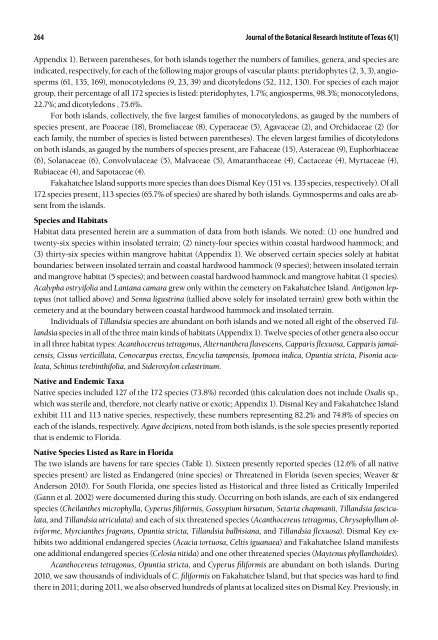A Floristic Inventory of Dismal Key and Fakahatchee Island
A Floristic Inventory of Dismal Key and Fakahatchee Island
A Floristic Inventory of Dismal Key and Fakahatchee Island
Create successful ePaper yourself
Turn your PDF publications into a flip-book with our unique Google optimized e-Paper software.
264 Journal <strong>of</strong> the Botanical Research Institute <strong>of</strong> Texas 6(1)<br />
Appendix 1). Between parentheses, for both isl<strong>and</strong>s together the numbers <strong>of</strong> families, genera, <strong>and</strong> species are<br />
indicated, respectively, for each <strong>of</strong> the following major groups <strong>of</strong> vascular plants: pteridophytes (2, 3, 3), angiosperms<br />
(61, 135, 169), monocotyledons (9, 23, 39) <strong>and</strong> dicotyledons (52, 112, 130). For species <strong>of</strong> each major<br />
group, their percentage <strong>of</strong> all 172 species is listed: pteridophytes, 1.7%; angiosperms, 98.3%; monocotyledons,<br />
22.7%; <strong>and</strong> dicotyledons , 75.6%.<br />
For both isl<strong>and</strong>s, collectively, the five largest families <strong>of</strong> monocotyledons, as gauged by the numbers <strong>of</strong><br />
species present, are Poaceae (18), Bromeliaceae (8), Cyperaceae (5), Agavaceae (2), <strong>and</strong> Orchidaceae (2) (for<br />
each family, the number <strong>of</strong> species is listed between parentheses). The eleven largest families <strong>of</strong> dicotyledons<br />
on both isl<strong>and</strong>s, as gauged by the numbers <strong>of</strong> species present, are Fabaceae (15), Asteraceae (9), Euphorbiaceae<br />
(6), Solanaceae (6), Convolvulaceae (5), Malvaceae (5), Amaranthaceae (4), Cactaceae (4), Myrtaceae (4),<br />
Rubiaceae (4), <strong>and</strong> Sapotaceae (4).<br />
<strong>Fakahatchee</strong> Isl<strong>and</strong> supports more species than does dismal <strong>Key</strong> (151 vs. 135 species, respectively). Of all<br />
172 species present, 113 species (65.7% <strong>of</strong> species) are shared by both isl<strong>and</strong>s. gymnosperms <strong>and</strong> oaks are absent<br />
from the isl<strong>and</strong>s.<br />
Species <strong>and</strong> Habitats<br />
habitat data presented herein are a summation <strong>of</strong> data from both isl<strong>and</strong>s. We noted: (1) one hundred <strong>and</strong><br />
twenty-six species within insolated terrain; (2) ninety-four species within coastal hardwood hammock; <strong>and</strong><br />
(3) thirty-six species within mangrove habitat (Appendix 1). We observed certain species solely at habitat<br />
boundaries: between insolated terrain <strong>and</strong> coastal hardwood hammock (9 species); between insolated terrain<br />
<strong>and</strong> mangrove habitat (5 species); <strong>and</strong> between coastal hardwood hammock <strong>and</strong> mangrove habitat (1 species).<br />
Acalypha ostryifolia <strong>and</strong> Lantana camara grew only within the cemetery on <strong>Fakahatchee</strong> Isl<strong>and</strong>. Antigonon leptopus<br />
(not tallied above) <strong>and</strong> Senna ligustrina (tallied above solely for insolated terrain) grew both within the<br />
cemetery <strong>and</strong> at the boundary between coastal hardwood hammock <strong>and</strong> insolated terrain.<br />
Individuals <strong>of</strong> Till<strong>and</strong>sia species are abundant on both isl<strong>and</strong>s <strong>and</strong> we noted all eight <strong>of</strong> the observed Till<strong>and</strong>sia<br />
species in all <strong>of</strong> the three main kinds <strong>of</strong> habitats (Appendix 1). Twelve species <strong>of</strong> other genera also occur<br />
in all three habitat types: Acanthocereus tetragonus, Alternanthera flavescens, Capparis flexuosa, Capparis jamaicensis,<br />
Cissus verticillata, Conocarpus erectus, Encyclia tampensis, Ipomoea indica, Opuntia stricta, Pisonia aculeata,<br />
Schinus terebinthifolia, <strong>and</strong> Sideroxylon celastrinum.<br />
Native <strong>and</strong> Endemic Taxa<br />
Native species included 127 <strong>of</strong> the 172 species (73.8%) recorded (this calculation does not include Oxalis sp.,<br />
which was sterile <strong>and</strong>, therefore, not clearly native or exotic; Appendix 1). dismal <strong>Key</strong> <strong>and</strong> <strong>Fakahatchee</strong> Isl<strong>and</strong><br />
exhibit 111 <strong>and</strong> 113 native species, respectively, these numbers representing 82.2% <strong>and</strong> 74.8% <strong>of</strong> species on<br />
each <strong>of</strong> the isl<strong>and</strong>s, respectively. Agave decipiens, noted from both isl<strong>and</strong>s, is the sole species presently reported<br />
that is endemic to Florida.<br />
Native Species Listed as Rare in Florida<br />
The two isl<strong>and</strong>s are havens for rare species (Table 1). Sixteen presently reported species (12.6% <strong>of</strong> all native<br />
species present) are listed as Endangered (nine species) or Threatened in Florida (seven species; Weaver &<br />
Anderson 2010). For South Florida, one species listed as historical <strong>and</strong> three listed as Critically Imperiled<br />
(gann et al. 2002) were documented during this study. Occurring on both isl<strong>and</strong>s, are each <strong>of</strong> six endangered<br />
species (Cheilanthes microphylla, Cyperus filiformis, Gossypium hirsutum, Setaria chapmanii, Till<strong>and</strong>sia fasciculata,<br />
<strong>and</strong> Till<strong>and</strong>sia utriculata) <strong>and</strong> each <strong>of</strong> six threatened species (Acanthocereus tetragonus, Chrysophyllum oliviforme,<br />
Myrcianthes fragrans, Opuntia stricta, Till<strong>and</strong>sia balbisiana, <strong>and</strong> Till<strong>and</strong>sia flexuosa). dismal <strong>Key</strong> exhibits<br />
two additional endangered species (Acacia tortuosa, Celtis iguanaea) <strong>and</strong> <strong>Fakahatchee</strong> Isl<strong>and</strong> manifests<br />
one additional endangered species (Celosia nitida) <strong>and</strong> one other threatened species (Maytenus phyllanthoides).<br />
Acanthocereus tetragonus, Opuntia stricta, <strong>and</strong> Cyperus filiformis are abundant on both isl<strong>and</strong>s. during<br />
2010, we saw thous<strong>and</strong>s <strong>of</strong> individuals <strong>of</strong> C. filiformis on <strong>Fakahatchee</strong> Isl<strong>and</strong>, but that species was hard to find<br />
there in 2011; during 2011, we also observed hundreds <strong>of</strong> plants at localized sites on dismal <strong>Key</strong>. Previously, in
















